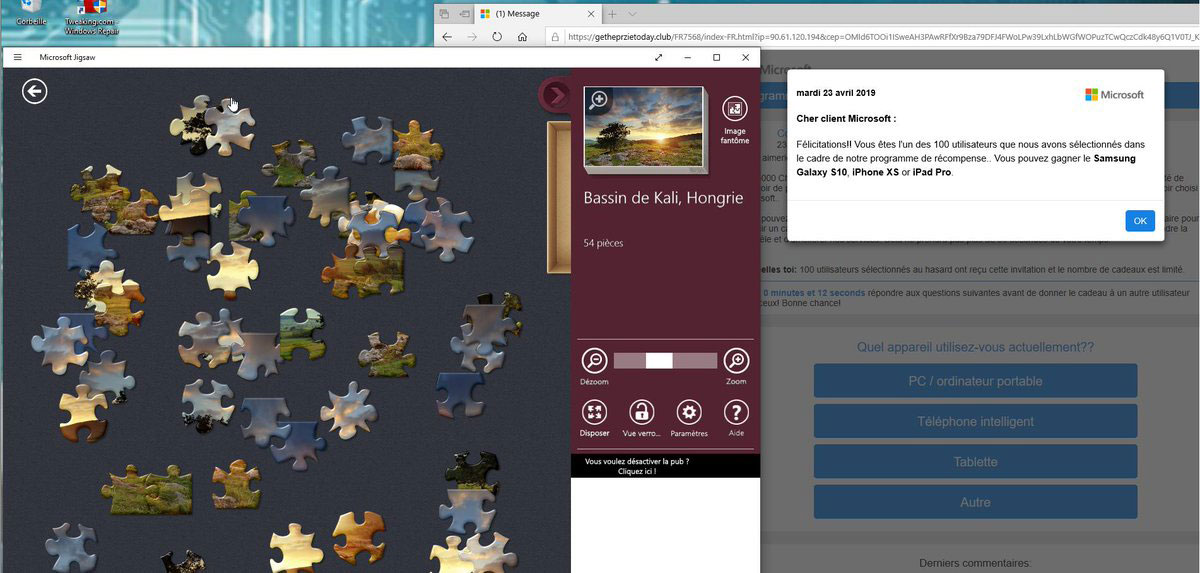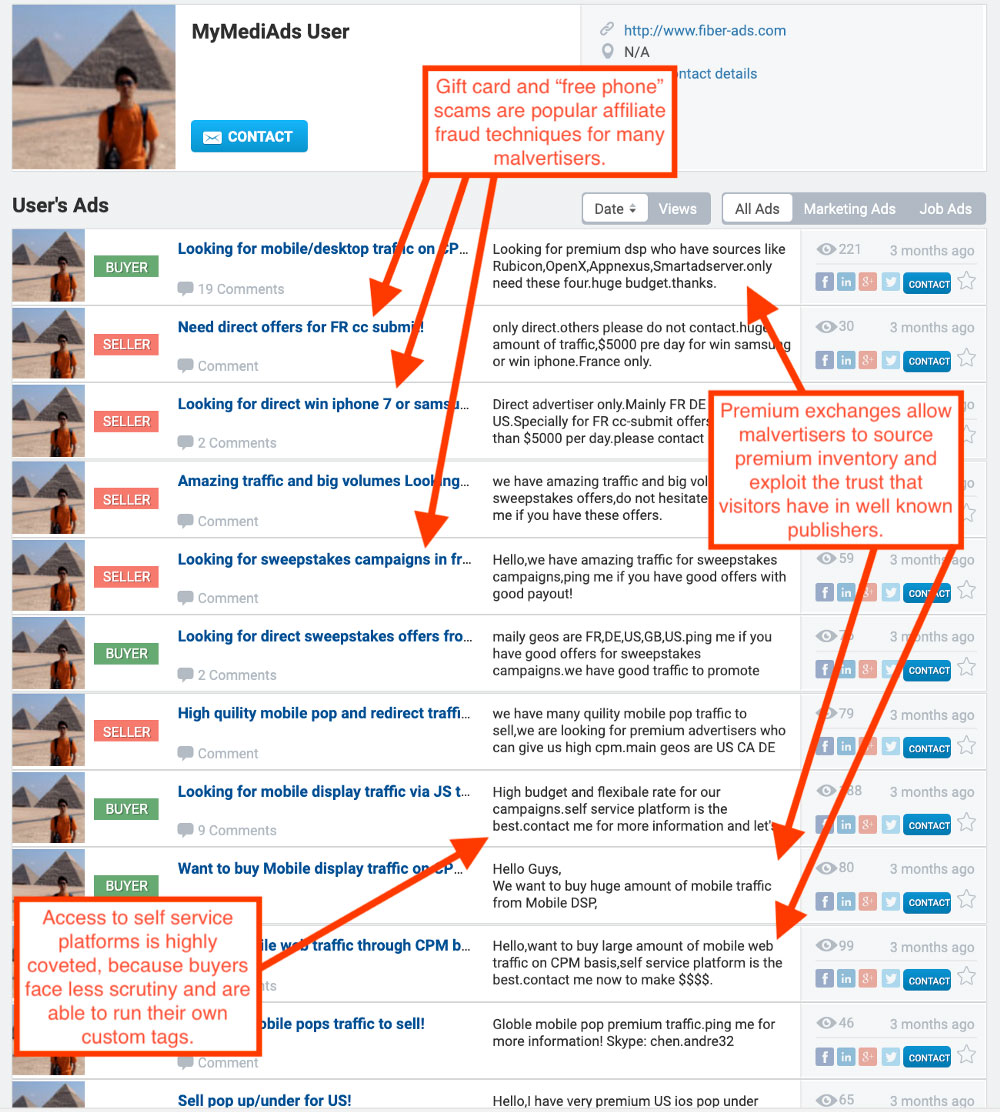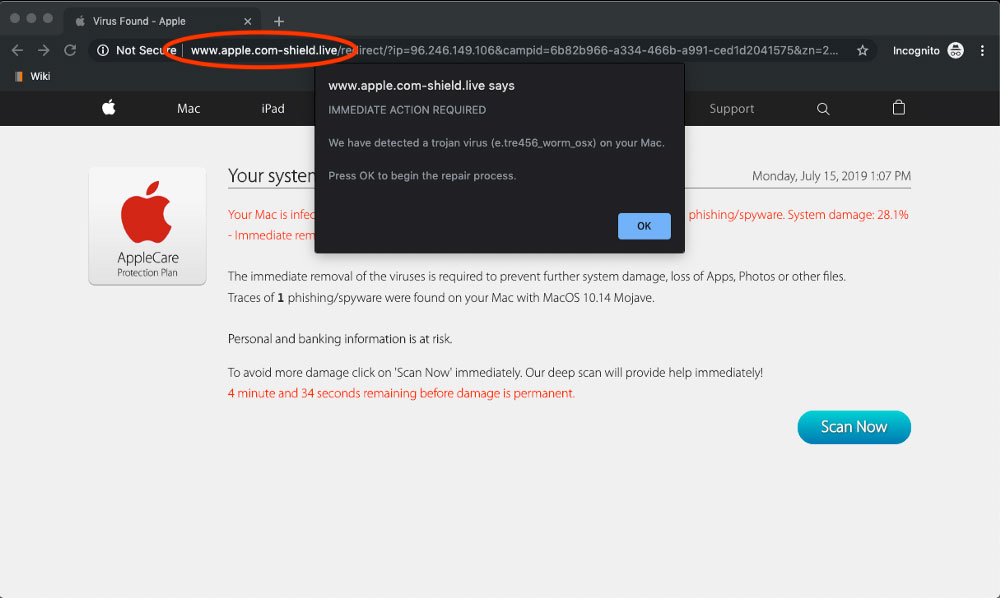
A group behind the recent outbreaks of malicious advertisements being displayed through Windows 10 apps and Microsoft games has been identified as being based out of Hong Kong. This group is behind millions of advertisements that redirect users to scams, malware, and adware bundles.
In April and June of this year, BleepingComputer reported on how French and German users were being targeted by malvertising that displayed tech support scams, phishing pages, and fake sweepstakes. What was making this attack unusual was that the ads were being displayed in free Microsoft games and Windows 10 apps that allowed them to escape the app and launch unwanted sites in a user’s default browser.

According to a report shared with BleepingComputer, advertising security company Confiant discovered a Hong Kong based advertiser that was creating corporate identities to partner with DSPs (demand-side platforms). It would then distribute their low quality and often malicious ads through the DSPs to other ad networks and publishers.
“In March 2019, we were fortunate to receive some feedback from one of our platform customers regarding a campaign that fit the attribution model for this attacker. We were told that the buyer, “fiber-ads”, has been active as of January 2019,” Confiant security engineer and researcher Eliya Stein stated in their report. “We were able to confirm this exact buyer with multiple platform partners as well. We were also told that they recently pivoted to a new corporate identity, “Clickfollow”.”
In addition to directly partnering with DSPs, “fiber-ads” was also a participant in the advertising marketplace MyMediAds.
In the image below, Confiant shows how this malvertiser was actively looking for access to premium exchanges and self-service platforms. They were also looking to advertise gift card, free Samsung or iPhone, and sweepstakes scams.

This malvertising group has been very successful, with over 100 million ads shown in 2019 alone and their two biggest peaks being in May 2019 and June 2019. The May campaign occurred around the same time frame that French users were reporting seeing these ads and June corresponds to when German users were reporting them.
“When visualized, campaign volumes associated with this attribution model paint a picture of a very active and persistent malvertiser. The two peaks below are approximately 28MM and 14.5MM impressions respectively with over 100MM impressions served this year as of mid June.”

Currently, the malvertising campaigns from this group are being monitored and blocked by Confiant, but the advertising security company warns that advertisers need to do better job in vetting their advertisers and if something feels at all off, they should avoid business opportunity.
“As a parting thought, we would like to suggest that ad tech platforms take extra care to vet their advertisers — and if something smells a bit fishy, like a buyer incorporated in a dodgy jurisdiction, it might be prudent to bypass that business opportunity altogether.”
Malvertising led to scams and malware
The malvertising campaigns were not being distributed solely to target Windows 10 apps and Microsoft Games. Instead they were targeting a particular subset of users and as Microsoft apps can be monetized with in-app ads, they were being displayed there as well.
When a user was served an ad from one of these malvertising campaign, the malvertiser’s ad server would determine if they were a user they wished to target with a scam ad.
If not, the user was shown a generic fake ad, but if the user was one being targeted, the ad code would automatically redirect the user to a scam page that showed sweepstake, free phone, and tech support scams.
Examples of the types of scams a mobile user may have seen are shown below.

In addition to tech support scams and free products, desktop users would also be shown more malicious payloads in the form of pages that push unwanted security programs and adware bundles.

As always, users should never download any software from a web site stating that a risk or security issue has been found. These commonly lead to malware and fake security software being installed on a computer.
Related Articles:
Windows 10 Apps Hit by Malicious Ads that Blockers Won’t Stop
Microsoft Patches PowerShell Core Security Bug to Fix WDAC Bypass
Windows 10 1903 Bug May Show Black Screen in Remote Desktop
Windows 10 SFC /scannow Can’t Fix Corrupted Files After Update
Bleeping Computer® is a community of individuals of all ages who are here to learn new information, to help each other, and to help their fellow peers. With that in mind, we ask that all members please follow these simple rules in order to create an atmosphere where everyone feels comfortable.
The rules are as follows:
- All information and instructions given within these forums is to be used at your own risk. By following or using any of this information you give up the right to hold BleepingComputer.com liable for any damages.
- All the forums are categorized by topics. Please post your questions or messages in the appropriate forum.
- Answers to many of the questions you may have can be found in the Tutorials Section, Glossary, or from other posts on the message boards. Please use the search functions, at the top right of each page, to find your answers. If you are still having problems, feel free to post your question.
- All help must be provided in the forums or on our Discord Server. We do not allow support to be provided or requested via personal message, email, or remote desktop control programs (Logmein, TeamViewer, etc).
- If a topic is posted in a forum that is not appropriate for the question, the staff has the right to move that topic to another better suited forum.
- The posting of any copyrighted material on our web site is strictly prohibited.
- Posting links in order to generate affiliate commissions is not permitted at BleepingComputer.com. Any posts that are deemed to be posted in order to generate affiliate commissions, regardless of the product being promoted, will be deleted. If a user continues to create affiliate SPAM posts, they will be banned.
- Posting links to non-Bleeping Computer malware removal guides is NOT permitted with the exception of security vendors who sometimes release specialized tools and instructional documentation. This is because it is impractical for BleepingComputer to monitor and review all such guides for accuracy, no matter how accurate those guides may, in fact, be.
- There will be no use of profanity on our message boards. This will not be tolerated and can lead to immediate suspension.
- When posting, please use proper grammar. Refrain from ‘text-message’ style substitutions of words like ‘u’ for ‘you’, and ‘ur’ for ‘your’. This is a multi-national forum, and some of our non-english speaking members must use translation software which is confused by abbreviations. Most of our volunteer members are very busy helping as many people as they can, and a post that is hard to read will often be overlooked.
- There will be no racial, ethnic, gender based insults or any other personal discriminations. This will not be tolerated and can lead to immediate suspension.
- There will be no posts meant to offend or hurt any other member, in a manner which is offensive or inflammatory. This includes flaming or instigating arguments.
- Spamming is not permitted; please keep all your posts as constructive as possible.
- Pornography, warez, or any other illegal transactions may NOT be linked in any shape or form.
- If you have questions regarding homework, we will only help you with general concepts. If you are looking for a complete solution or answer, we will most likely just delete your post.
- No subject matter will be allowed whose purpose is to defeat existing copyright or security measures. If a user persists and/or the activity is obviously illegal the staff reserves the right to remove such content and/or ban the user. This would also mean encouraging the use or continued use of pirated software is not permitted, and subject to the same consequences.
- If you are receiving assistance in the Virus Removal forum, you are not allowed to request assistance for the same computer at another malware removal forum. This is to prevent conflicting advice from causing issues with your computer or making it unbootable.
- This forum has the right to request alteration or deletion of any offensive post. If this is not done in a prompt manner, the Staff will delete the material themselves.
- Posts may be deleted for any reasons the forum administrators deem reasonable.
- Pictures may be posted as long as they are not explicit, offensive, or copyrighted.
- Advertisements, of any sort, are not permitted. This includes member names and links to commercial sites in Signatures, or in posts. You also may not solicit sales for Newegg through the use of promotion or coupon codes. If you would like to advertise on our site, contact us here.
- In order to reduce spam on the site, you will not be able to add a signature to your account until you reach 25 posts. Signatures are limited to 5 lines or 2000 characters; whichever comes first. If your signature is larger than the allotted size given or deemed unacceptable, you will be requested to adjust your signature. Failure to comply will result in the removal of your signature.
- Only one image per signature. Images in signatures must also be no larger than 500 pixels wide X 90 pixels high. If you have more than one image you will be requested to remove one. If this is not done in a timely manner the staff has the right to modify your signature to abide by these rules.
- Any links in signatures or profiles cannot be commercial in nature or they will be removed by BleepingComputer. You may not put links in your signature soliciting donations unless you are in certain member groups. Those member groups that are allowed will be expressly notified. If you have a personal website or off-site help resource, that is more than fine, but you can not sell products or services through your signature. Multiple links to the same site, unless for a very specific reason, are not permitted in a signature and will be removed.
- Avatars must be in good taste. This means no vulgar or violent images, pornography, or profanity. Avatars that are found to be inappropriate will be removed at the discretion of the staff.
- Linking to hate, anti-Semitic, racist, pornography, warez, or other illegal sites is not permitted.
- Links in your signature must be unobtrusive and can not use formatting so that attention is brought to them.
- Member’s display names can not be email addresses. This rule is in place to protect you from spam bots who will pick up your email address and spam you.
- Members may have only one account on this forum. There is no need to have more than one.
- Any impersonation of a user from these forums, in any mode of communication, is strictly prohibited and will result in a banning.
- Linked and locked topics are pruned regularly to reduce page clutter. If you have a question about where your topic went, please PM a Moderator or Administrator before starting a new topic asking where it went, or posting a duplicate of the original topic. We will be happy to provide you with a link to the new location, or a reason why it was locked and/or removed.
Violation of any of these rules can lead to a banning of the user from our Web Site and a deletion of their account. The consequences will be determined by the Staff on a case by case basis.
When posting you agree that the administrators and the moderators of this forum have the right to modify, delete, edit or close any topic, signature, account, or profile data at any time that they see fit. If you have any questions concerning this, please do not start a new thread, but rather private message to an administrator or moderator.